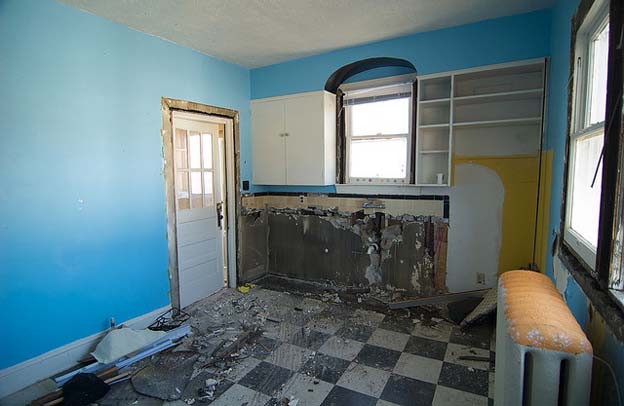 The number of Americans remodeling their homes is expected to increase in 2012, and the need for updating their insurance polices will likely rise as well. It’s important to have the right amount and type of homeowners insurance both during and after the renovation, according to the Insurance Information Institute.
The number of Americans remodeling their homes is expected to increase in 2012, and the need for updating their insurance polices will likely rise as well. It’s important to have the right amount and type of homeowners insurance both during and after the renovation, according to the Insurance Information Institute.
A study by the Remodeling Futures Program at the Joint Center for Housing Studies at Harvard University predicts that there will be a 5.9 increase in spending on remodeling projects in 2012.
“If you plan to remodel your home, contact your insurance agent, broker or company representative. You want to be sure that you have all of the necessary insurance coverages during and after the renovation,” Jeanne M. Salvatore, senior vice president and consumer spokesperson for the I.I.I. said in a statement. “Don’t make the mistake of waiting until after your renovation is underway or you could find yourself dangerously underinsured.”
The I.I.I. points out the following four key steps when remodeling a home:
1. Talk to an insurance agent, broker or company representative before starting a project
Let the insurance company know about any remodeling plans. Ask if it’s necessary to update a homeowner’s insurance policy and whether other types of insurance are needed during the project.
If considering a simple, do-it-yourself project, only take it on if you are qualified to do the work. If friends or family are going to help out, make sure that you have sufficient liability protection in the event someone gets injured. This includes raising the amount of no-fault medical protection on your home insurance policy so that if someone is injured he or she can simply submit the doctor’s bills to your insurance company; this can lessen the risk of being sued.
If planning a bigger project, look into a getting a builder’s risk policy (also known as a “course of construction” policy). It may be available as a stand-alone policy, or as an add-on to a homeowners policy. This coverage generally protects a home from damage incurred during construction, including wind and rain, theft of materials such as carpeting, tile or wood (though not the contractor’s equipment), and vandalism.
2. Verify that your contractor has insurance coverage
Ask to see a copy of any contractor’s insurance policies. The contractor should have both a commercial business/general liability insurance policy and workers compensation. It is important that the workers remodeling your home be adequately insured so that if a worker is injured he or she does not sue you.
If the contractor is not adequately insured or is unwilling to verify their insurance coverage, consider hiring someone else.
3. Keep records and receipts
Take photographs before, during and after the renovation so there’s a visual record of all of the work done on your home.
Keep copies of any contractor contracts, and receipts for work done and materials purchased.
If purchasing new belongings as part of the remodeling, keep receipts and add the information to the home inventory. The I.I.I.’s free Know Your Stuff® – Home Inventory software helps make creating and updating a home inventory simple. The I.I.I. also has a companion home inventory iPhone app (search for “iii inventory” in the Apple app store).
4. Update your insurance coverage after the renovation
Make sure that the insurance company knows about the improvements to the home. After a major renovation, it may be necessary to increase the amount of insurance required to cover rebuilding the home. Be prepared to forward all records and receipts to the insurance company so they can accurately assess the insurance needs.
It may be necessary to purchase additional coverage for personal possessions. If purchasing art or other expensive items, find out whether additional coverage is needed in the form of a floater or endorsement. This is an individual policy for expensive items that provides a higher level of insurance coverage.
Consider getting more liability protection if adding a swimming pool or hot tub as these are considered “attractive nuisances” and could leave your vulnerable to lawsuits. An insurance agent can discuss getting an excess or umbrella liability policy as a cost-effective way to increase overall liability protection.
Ask about discounts. A discount of at least 5 percent might be possible after the installation of stronger doors, smoke detectors, a burglar alarm or dead-bolt locks. Some companies may cut premiums by as much as 15 or 20 percent for a sophisticated sprinkler system and a fire and burglar alarm that rings at the police, fire or other remote monitoring stations. If the heating, plumbing or electrical systems have been updated, it may be possible to get a reduction in premium as this reduces the risk of fire and water damage. Adding storm shutters or shatter-proof glass, reinforcing the roof or purchasing stronger roofing materials may also reduce insurance costs.
If the alteration to the home was as a result of a major life change such as a marriage, the addition of a new child, establishing a home-based business or an elderly relative moving in, it might be necessary to reevaluate a number of other insurance needs. Now is a good time to discuss these major life events with an insurance professional to see if they should update your life insurance, get business insurance or secure other insurance coverage.












